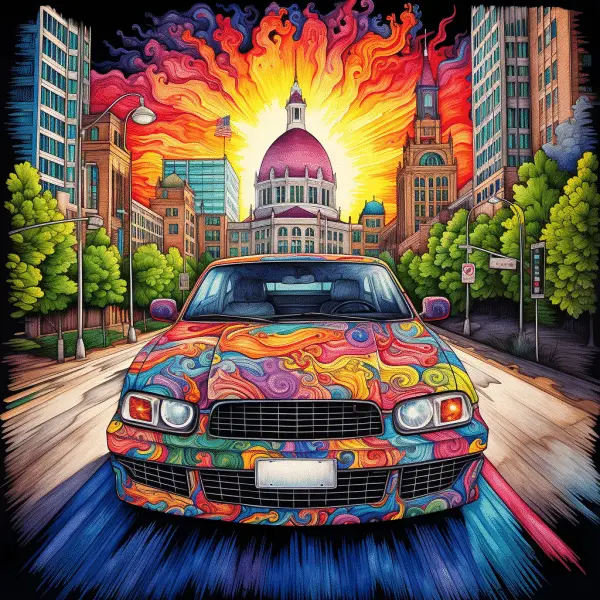
Michigan Window Tint Laws: Stay Legal, Drive Safe

There are a lot of great roads to drive through during both the summer and winter times in Michigan tint laws. If you’ve spent some time on Michigan’s road, you’ve probably come across various cars with tinted windows and flashy rims. Have you once considered tinting your car windows because of that? Like many people, you might be envious of how cool the tinted vehicles appear.
Just because the Michigan state allows the vehicle owners to tint the windows, it doesn’t mean that there are no rules and regulations set in place to govern the same. You definitely don’t wish to be pulled over and be locked behind bars for not following the Michigan tint law. This article is set to help you in every point and direction to take with vehicle tinting.
Extra car tinting is believed to block the radiant heat to keep the interior cool. Over the past ten years, tinting has been quite popular in Michigan. The vehicles with tinted windows might appear attractive or have superb interiors, but on the negative side, they attract unfriendly consequences from law enforcement agents.
There are Michigan window tint laws that you need to know as early as yesterday. They are explicitly clear, and you’re expected to operate within the recommended limits.
What Does The Michigan Tint Laws Say?
Michigan tint laws were established in 2000. They provide the necessary information that you need to know about the tinting of the car’s window. The major aspects covered include how reflective or dark the tint is.
Let’s look at the tint rules and regulations as stated by the tinting laws of Michigan:
Visible Light Transmission (VLT) is the amount of light that can pass through the car window. The percentage of VLT varies from the SUV to sedan cars or vans. The higher the VLT, the more light can pass through the tint film into the car’s interior. For example, 75% tint means allowing 75% of light, whereas the 5% tint only allows 5% of light, making the 5% tint film much darker.
Michigan Tint Laws: The Legal Tint Film for the Passenger Vehicles
- Front Windshield: Not allowed
- Side windows of the front seats: 35% tint film only up to 4 inches from the top of the window.
- Side windows of the back seats: tint darkness is allowed up to only 35%.
- Rear window: 35% and below tint darkness allowed
Michigan Tint Laws: The Legal Tint Film Limits for the Multi-purpose Vehicles
- Front Windshield: Tinting of the front windshield is illegal
- Side windows of the front seats: 35% and below of tint darkness can be used up to the level of 4 inches from the window’s top.
- Side windows for the back seats: maximum of 35% tint darkness is allowed.
- The rear window: less than 35% tint darkness.
Other Michigan Tint Laws
Before you decide on whether to tint the windows of your car or not, other Michigan tint laws are considered crucial in every step you take when tinting the windows of your car. It’s recommended that you check and adhere to the following:
- If the rear windshield has the obstruction of the tint, you must have the side mirrors.
- Colored tints are allowed in Michigan tint laws except for the Gold and Silver colored tints.
- The manufacturers and installers of the tint don’t necessarily have to certify film sold to the clients in Michigan.
- No sticker helps in identifying a legal tinting company in Michigan. Therefore, you don’t have to struggle searching for a certified firm to install the window tint.
Michigan tint law gives room for special tint to people with some medical conditions. Some conditions that Michigan tint laws consider for one to exceed the legal limits of tinting include Lupus, sunlight allergy, and melanoma. Always carry proper documentation from the certified medical professional. The information is important since you will have to present it to the police officers whenever they pull you over for the excessively tinted windows.
Why Michigan Tinting Law?
For most people, window tinting is only for cosmetic purposes, and in common scenarios, it doesn’t affect the driver’s visibility. While tinting can’t cause any daytime issues, it can be a serious problem at night because of the low lighting. Therefore, operating excessively tinted vehicles at night poses many risks to the road users and the passengers since the driver’s visibility is diminished. The night darkness affects vision and adding an extra layer of the semi-transparent film lowers the visibility for the worst case.
When the drivers’ visibility is impaired, they can’t recognize the pedestrians, road lanes, bicyclists, road signs, and even other vehicles. Michigan tint laws guide the motorist’s community so that all parties using the road can live and operate amicably in a safer environment.
What Happens if You Break the Michigan Tint Laws?
Any police department can turn you in if you can’t adhere to the Michigan window tinting laws. For example, tinting the front windshield causes obstructed vision, and you can be judged for civil infractions. Excessive black tint at the front window can lead to unnegotiable punishment. Notably, violating the Michigan tint laws can attract you a fine of not less than $95 plus two points from your driving record.

Conclusion
Michigan state permits tinting of the side and rear windows, but not the front windshield. However, other specific laws govern the percentage of VLT and the nature of the tint film you can install. All the information is found in the Michigan state tint laws.
Ever since the enactment of the Michigan tint laws, they have been implemented strictly. Hence you must review the tint film of your vehicle more regularly to avoid crossing into the lanes of the authorities enforcing the law.
Tint less than 35% is illegal in Michigan. The front windshield should not be tinted, but you can add the tint darkness to the side windows so long as you don’t make the VLT fall less than 35%.
Since the Michigan tint laws allow the whole side window to be tinted apart from the upper 4 inches, you ought to follow that. Either way, it logically means that the police officers can even pull you over if they find out that the tint is too dark, reflective, and it’s covering the entire window.
